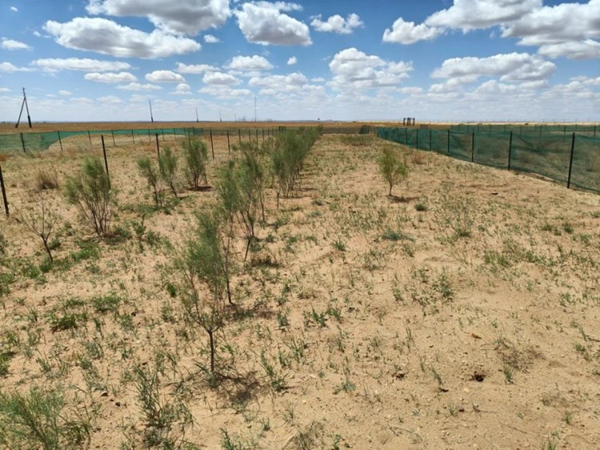【Xinhua】Chinese experience helps ecological restoration efforts in Mongolia
2023-10-12

This photo taken in June 2023 shows a part of the experimental demonstration zone for ecological restoration of desertified grasslands jointly built by Chinese and Mongolian scientists on the northern outskirts of Choir, capital city of Mongolia's Gobi Soumber Province. (Xinjiang Institute of Ecology and Geography/Handout via Xinhua)
BEIJING, Oct. 11 (Xinhua) -- On the northern outskirts of Choir, capital city of Mongolia's Gobi Soumber Province, a patch of land of about one hectare has been dug with dozens of trenches. These are not ordinary trenches, but are carefully designed to intercept sand and collect snow.
The patch of land is a part of the experimental demonstration zone of about 20 hectares jointly built by Chinese and Mongolian scientists, who have been exploring ways to achieve ecological restoration of desertified grasslands.
Mongolia has been suffering from serious ecological degradation and sandy desertification, as exemplified by frequent sandstorms in winter and spring, which also affect surrounding countries such as China, the Republic of Korea and Japan.
Winter and spring are snowy and windy seasons in Mongolia, and the flat terrain there allows the wind to disperse sand and snow leeward. "We have been using our Chinese experience to help Mongolia block the flow of sand and make better use of snow, a precious water resource," said Li Shengyu, a professor from Xinjiang Institute of Ecology and Geography (XIEG), Chinese Academy of Sciences.
He explained that the method called micro-terrain reshape has also been used in places with similar environmental conditions in China, such as the Inner Mongolia Autonomous Region and the Xinjiang Uygur Autonomous Region.
By digging trenches to a depth of about one meter, and then piling the excavated earth on the sides, an uneven terrain is created. "The rough terrain makes the wind-blown sand and snow flow to accumulate in the trenches, where the snow melts and becomes an important water resource," Li said, adding that they then planted some shrubs and grass in the trenches, which grew well from the sustenance provided by the snowmelt water and sand deposition.
The whole process seems to be simple but the technique lies in the details, said Lei Jiaqiang, a professor at the XIEG.
"For example, we need to adjust the direction of the trenches according to the direction of the wind, and we also need to control the depth of the trenches depending on wind speed. At the same time, the plants planted in the trenches need to be drought-tolerant with high resistance to adversity," Lei added.
Moreover, to prevent the evaporation of the snowmelt water, the Chinese scientists put some new materials in the trenches, such as impermeable sand, a special type of sand that is breathable but does not allow water to permeate.
"We've found that this approach costs less and helps grasslands achieve recovery naturally," Li said.
In addition to this micro-terrain reshape method, Chinese scientists have also applied other techniques to control desertification, such as rapid establishment of protection forests by machine, fly-seeding, enclosing of sandy pastures, and utilisation of the restoration potential of natural ecosystems.
According to statistics from the XIEG, compared with the pre-treatment period, the grassland in the demonstration zone saw a 50 to 208 percent increase in above-ground pasture production, an 88.29 percent reduction in surface sand flux, and a 10 to 45 percent increase in vegetation cover, respectively.
"These positive results prove that this approach has great application prospects, and we hope to promote this model in more areas," said Li.
These cooperation efforts between Mongolian and Chinese scientists have already delivered positive impacts on desertification control and land degradation research, said Akhmadi Khaulenbek, an expert at the Institute of Geography and Geoecology of the Mongolian Academy of Sciences.
"I believe our collaboration will not only positively impact Mongolia, but also other East Asian countries affected by yellow dust storms that originate on the Mongolian plateau. We can solve pressing regional and global issues together and improve the well-being of people," he said.
Desertification is the cancer of Earth, which can spread to other areas, causing environmental and social problems, Lei said.
"The causes of desertification are very complex and are affected by climate change, human activities, geographical environment and so on, and so we need to apply different approaches according to different local conditions," Lei explained.
At present, the XIEG is actively carrying out cooperation on desertification control in Belt and Road Initiative (BRI) participating countries, and has set up several demonstration zones in Central Asia and Africa.
"Desertification governance is closely related to sustainable development and building a community with shared future for mankind. In the future, we can make use of more modern technologies, such as big data, artificial intelligence and the BeiDou system, to achieve harmony between human and aeolian environments," Lei added.
Contact:
LIU Jie
Xinjiang Institute of Ecology and Geography, Chinese Academy of Sciences
Phone: 0991-7885505
E-mail: liujie@ms.xjb.ac.cn
Web: http://english.egi.cas.cn/



